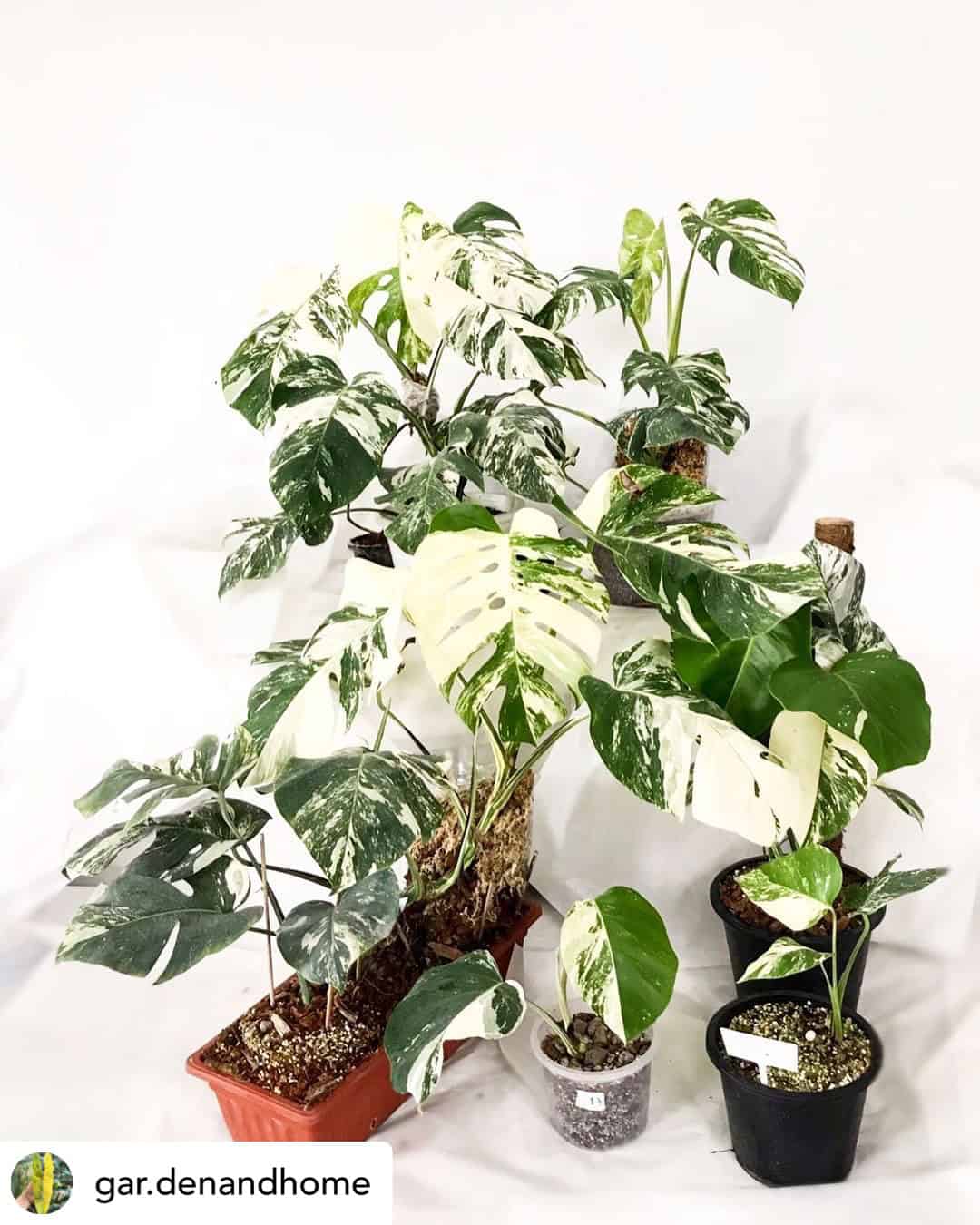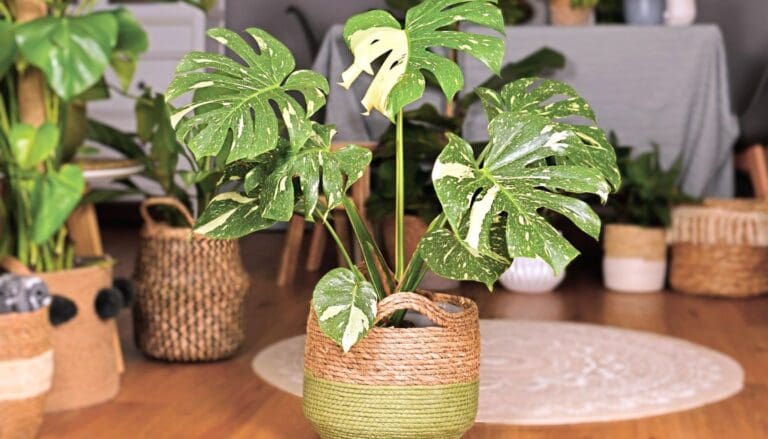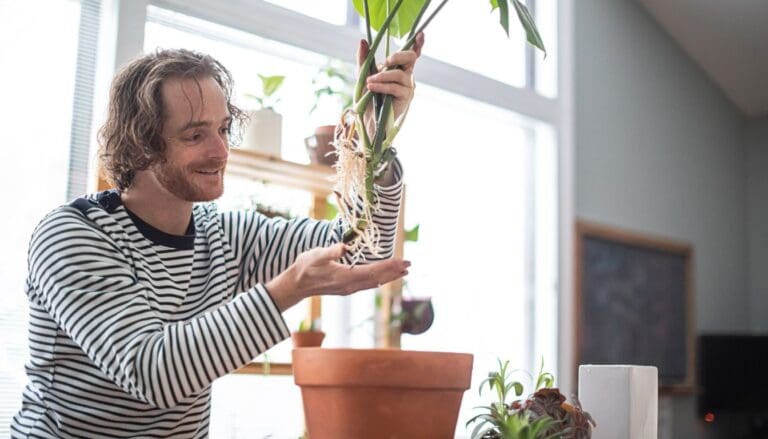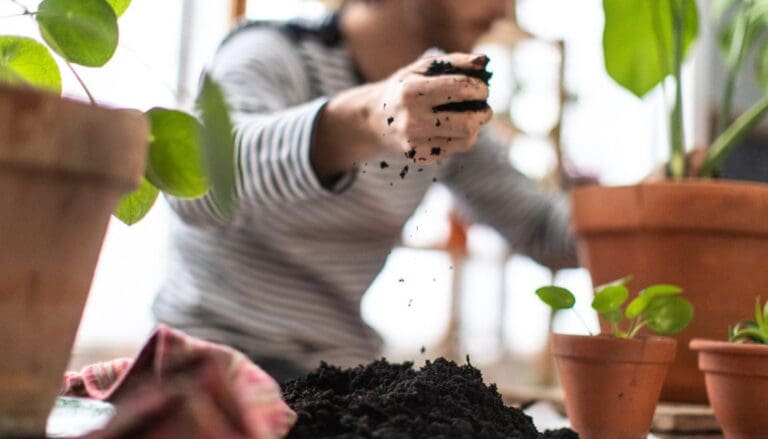My Top 10 Tips For Training Monstera to Climb
Training a Monstera to climb can transform your indoor space with lush, vertical greenery. These tropical plants not only look amazing, but climbing also helps them grow strong and healthy.
I know from experience that guiding them to grow upwards can enhance both their beauty and vitality. Helping your Monstera climb gives you a chance to engage with the plant more closely and enjoy its unique growth journey.
Have you ever wondered how to make your Monstera grow tall and lush? It’s simpler than you might think, and you don’t need a green thumb to get started.
Using a moss pole or trellis can make a big difference in encouraging your Monstera to reach new heights. Whether you’re a seasoned plant parent or just beginning, you’ll find these tips helpful. I’d love to hear your favorite plant-training stories or tips in the comments below! 🌿😊
Please note: Simplify Plants is reader-supported. As an Amazon Associate, I earn from qualifying purchases made by our readers with no extra cost added to you all! Some links in the post are affiliate links and I get a commission from purchases made through links in the post.
1) Choose a sturdy moss pole

When it comes to training my Monstera to climb, choosing a sturdy moss pole is essential! 🌿 The right pole supports the plant and helps it grow strong and healthy.
First, I make sure the moss pole matches the size of my Monstera. For smaller plants, a shorter pole around 12 to 18 inches works well. It’s so cute to watch them start their climbing journey!
For bigger Monsteras, I use a taller pole, about 2 to 3 feet. This gives them plenty of space to stretch and show off their impressive leaves.
A sturdy moss pole should be made from durable materials. I prefer sphagnum moss poles because they’re great for holding moisture and helping the plant develop strong aerial roots. Have you ever noticed how happy your plant looks when it gets enough water? 😊
I also make sure the pole is securely placed in the pot. If it’s wobbly, my Monstera might topple over. I push the pole into the center of the pot and pack the soil tightly around it. That way, both the pole and plant stay balanced.
Sometimes, I use bamboo stakes or even a wall-mounted trellis for my Monsteras. These options are handy when I want to get creative with my plant’s setup. Ever tried a wall-mounted trellis? It can be a fun DIY project!
And lastly, don’t forget to regularly check the moss pole for any signs of wear and tear. A strong support ensures my Monstera continues to climb high and stay healthy.
Ever had trouble picking the right moss pole? Share your experiences and tips in the comments below! 🌱✨
2) Use Soft Plant Ties
When it comes to training your Monstera to climb, soft plant ties are a game-changer.
I love using soft ties because they’re gentle on the plant. They won’t cut into the stems or leaves. Think of them like a cozy hug for your Monstera! 💚
Soft ties can be made from materials like VELCRO, fabric strips, or even cut-up pantyhose. These options are perfect for holding the plant in place without damaging it.
When tying your Monstera, make sure to do it loosely. You don’t want to restrict its growth. Just like us, plants need a bit of freedom to thrive.
I find fabric strips from old t-shirts work great. It’s eco-friendly and gives your plant a snug but comfortable fit. Plus, it’s a fun way to recycle!
Do you use something different? Share your tips in the comments below—I’d love to hear them!
Regularly check your ties as your Monstera grows. This way, you can adjust them to keep up with the plant’s growth without causing any harm.
Remember, supporting your Monstera with soft ties not only helps it climb better, but it also encourages healthier growth and bigger leaves. 🌿
Anyone else have funny stories about trying to wrangle their unruly Monstera? Drop them in the comments!
3) Rotate the plant regularly

I can’t stress this enough: rotate your Monstera regularly! 🌿 Why? Because it helps the plant grow evenly and prevents it from leaning too much in one direction.
Every few weeks, give your Monstera a gentle turn. This ensures that all sides get equal light. Without rotation, one side may become leggy, while the other gets overshadowed.
Think about it like getting an even tan! ☀️ Your plant loves soaking up that sunlight from different angles. It makes for healthier growth and more vibrant leaves.
One trick I use is to rotate the Monstera every time I water it. This simple habit keeps me on track. Plus, it’s fun to watch the plant shift and grow in new directions over time.
Have you ever noticed your Monstera leaning towards the window? That’s it reaching for the sun! By rotating it, you’re giving it the full 360-degree sunbathing experience.
And it’s not just about looks. Rotating the plant can also prevent the weight from shifting too much to one side. That means less chance of your Monstera tipping over. No one wants a plant accident!
Don’t forget to share your own rotation hacks! Do you have a reminder set on your phone? Or maybe tie a colorful string to a branch as a reminder? Drop your tips in the comments below. Let’s help each other out! 💬👩🌾
4) Provide bright, indirect sunlight
One of the best ways to train your Monstera to climb is by giving it bright, indirect sunlight.
Your Monstera loves light, but too much direct sun can burn its leaves 😱. Think of it like a sunburn for your plant. Ouch!
I place my Monstera near a window with sheer curtains. This way, it gets plenty of light without the harsh rays.
Bright, indirect light for about 5 to 8 hours a day is ideal. Do you have a favorite spot in your home with these conditions? 🌞
If natural light isn’t plentiful, no worries! You can use artificial lights. Just make sure they mimic the spectrum of natural sunlight.
I’m always careful about my Monstera’s light needs. Meeting this requirement helps it grow and climb beautifully. Have you noticed a difference in your Monstera’s growth with more light?
I’d love to hear your experiences! Drop a comment and let’s chat. 🌿
5) Maintain High Humidity

To keep my Monstera happy and climbing, maintaining high humidity is key. These plants love a moist environment. Wondering how to achieve that?
I use a spray bottle to mist the leaves regularly. It’s like giving my Monstera a spa treatment! 🌿
Ever considered a humidifier? It’s a game-changer. By increasing humidity levels, my Monstera looks fresher and greener. Plus, other plants love it too! 🌱
Grouping plants together can also help. It creates a little humidity boost as they release moisture around each other. Imagine it’s plant teamwork! 💧
Pebble trays work great as well. Just fill a tray with pebbles and water, and place your plant pot on top. It’s simple and effective at keeping humidity levels up.
Have you tried any of these methods? Drop your tips in the comments! 🌿
6) Water Consistently but Not Excessively
Watering your Monstera can make a big difference in how well it climbs! 🌿 It’s crucial to keep the soil consistently moist but not waterlogged.
I water my Monstera when the top two to three inches of the soil feel dry. Imagine touching a sponge that’s just been wrung out—damp but not soggy. This helps prevent root rot and supports healthy growth.
Have you ever noticed how thirsty plants tend to wilt? Well, Monsteras do that too. Keep an eye on your plant’s leaves, and they’ll tell you when they’re thirsty. Drooping leaves are usually a sign that it’s time for a drink.
To make things easier, I sometimes use a moisture meter. It’s super handy and takes the guesswork out of watering. If you don’t have one, just poke your finger into the soil. Simple, right?
Don’t forget to adjust your watering routine with the seasons. Monsteras don’t need as much water in the winter as they do in the summer. So, during those colder months, water sparingly.
Ever left a plant sitting in water? It’s like sitting in a puddle—uncomfortable and bad for health! Always make sure your pot has drainage holes. Excess water should easily flow out to prevent stagnant water around the roots.
What are your tips for watering houseplants? Share in the comments! 💧🪴
7) Feed with a balanced fertilizer

Using a balanced fertilizer is essential for helping your Monstera climb well. 🌿 Just like people need a good diet to stay healthy, so do plants!
I recommend using a water-soluble fertilizer that you can easily mix into your watering routine. This will ensure your Monstera gets the nutrients it needs.
During the growing season, usually spring and summer, feed your Monstera once a month. This helps it grow strong roots and leaves, which are crucial for climbing.
Ever noticed how you feel more energetic after a good meal? Your Monstera feels the same way after getting fed! It will grow more vigorously, making it easier to train up a support.
Be careful not to over-fertilize. Just like too much candy isn’t good for us, too much fertilizer can harm your plant. Stick to the recommended amount on the package to keep it safe. 🍭
Mix the fertilizer with water and apply it evenly to the soil. Make sure the soil is moist beforehand, as applying fertilizer to dry soil can damage the roots.
Got any funny or memorable moments while feeding your Monstera? Share in the comments below! 🌱💬
8) Prune back excessively long vines
Pruning might sound scary, but it’s super helpful for your Monstera! Sometimes, vines can grow too long and cause the plant to look messy. Trimming them back can make your Monstera look neat and tidy. Who doesn’t love a well-groomed plant? 🌿
When you notice vines getting too lengthy, grab your clean pruning shears. Cutting off those extra-long vines can actually encourage new growth. Plus, it helps the plant focus its energy on the main vines and leaves.
Don’t worry about hurting your plant. Monsteras are pretty tough! Think of it as giving your Monstera a fresh haircut. ✂️ Just snip where the vine is too long, and make the cut above a leaf node. These nodes are where new growth will come from.
Been there, done that? Share your pruning experiences! Or, if you’re nervous, let me know your questions. We can all learn together and make our Monsteras thrive! 🌱
What other plant care tips do you want to know? Drop your thoughts in the comments! ⬇️
9) Repot When Roots Outgrow the Pot

Is your monstera’s pot feeling a bit too cozy? If you see roots peeking out of the pot’s drainage holes or spiraling around the top, it’s time for a new home! 🪴
I usually check my monstera’s roots once a year. If they look crowded, I get ready to repot.
Repotting allows the plant to continue growing strong and healthy.
Spring is the best time for this task. The plant is about to enter its peak growth season, so it adapts quickly to a new pot.
Pro tip: Pick a pot that’s 2 inches larger in diameter than the old one.
Gently remove the monstera from its old pot. Sometimes, turning the pot upside down while supporting the plant works best. I try not to yank on it to avoid damaging the roots.
Inspect the roots carefully. If you spot any damaged or rotting parts, trim them with clean scissors. Healthy roots are key to a thriving plant!
Place the monstera in the new pot, ensuring it sits at the center. Fill in with fresh potting soil, but don’t pack it too tight. You want the roots to breathe!
Has anyone else found repotting to give their monstera a new lease on life? Let’s chat in the comments below! 🥳 What’s your best repotting tip?
10) Dust leaves frequently
Did you know that dusting your Monstera’s leaves is super important? Let me explain why.
Dust can block your plant from getting the sunlight it needs. This can slow down growth. By keeping those leaves clean, you’re helping your Monstera thrive! ✨
I like to use a soft cloth or a microfiber towel. Just gently wipe the leaves to remove dust. It’s so easy!
Sometimes I mix a little water with a mild soap. This helps to get rid of more stubborn grime. Remember to rinse the leaves with plain water afterwards.
Another great tip: Use a spray bottle to mist the leaves before wiping. This can make dusting even easier.
How often should you do this? I recommend once a week. It only takes a few minutes and makes a huge difference.
Got pets or kids? Tell them it’s a fun game! They can help, and it turns into a mini family activity!
Have you dusted your Monstera lately? Share your tips or pictures in the comments below! 😊🌱
Understanding Monstera Growth Habits
Monsteras are known for their climbing nature and distinctive aerial roots. Successfully training a Monstera to climb involves understanding these natural tendencies and providing the right support.
Natural Habitat and Climbing Tendencies
In rainforests, Monsteras grow as climbers, attaching themselves to trees and climbing towards the light. This is a vital part of their survival, allowing them to reach sunlight in dense forest conditions.
Being aware of this can help you create an environment that mimics their natural habitat.
Have you ever noticed how your Monstera reaches out? It’s looking for something to grab onto, like a moss pole or a trellis.
Creating this environment at home means using supports like a moss pole or bamboo stakes.
Have you tried any of these? What works best for you?
Using these supports not only helps your plant grow tall but also keeps it healthy and lively.
The Role of Aerial Roots
Aerial roots are an important part of a Monstera’s climbing ability. These roots reach out in search of surfaces to latch onto. They take up moisture and nutrients from the air, helping the plant thrive.
Personally, I think these roots are fascinating! Ever given them more than a passing glance? 😄
When you see these roots, you know your Monstera is ready to climb. It’s like a green light for action!
Keep the plant hydrated so these roots can grow strong. And don’t forget a balanced fertilizer. It’s like giving your Monstera a nutritious meal, making those aerial roots strong and healthy.
Share your experiences with your Monstera’s aerial roots in the comments! Have any funny stories or tips? Let’s chat! 🌿
Preparing Your Monstera for Training

Getting a Monstera ready to climb requires the right support, proper pruning, and the best soil and pot. Let’s dive into these important steps! 🌿
Choosing the Right Support Structure
First, decide on the kind of support for your Monstera. I prefer moss poles because they mimic the natural climbing surfaces found in rainforests. A sphagnum moss pole keeps moisture, encouraging root growth.
Other good options are bamboo stakes or a wall-mounted trellis.
Make sure the pole or trellis is sturdy and tall enough for future growth. 🪴
I often place the support in the center of the pot for balance. If the pole is too close to the side, the plant might tip over.
Proper Pruning Techniques
Pruning is key to healthy growth. I always inspect the roots before repotting. Healthy roots are a must! If you notice any rot, trim those parts off.
Regular pruning also helps manage growth direction.
Here’s a tip: prune the aerial roots slightly. This can encourage new ones to grow, giving your Monstera a fuller look. ✂️
Don’t cut too much at once—this can stress the plant. What’s your go-to pruning tool? Mine is a pair of sharp shears!
Optimal Soil and Pot Selection
Your Monstera needs well-draining soil to thrive. I like to use a mix of potting soil, peat, and perlite. This mix holds moisture but also provides aeration.
Choose a pot that matches the size of the plant. A pot that’s too big can hold too much water and lead to root rot. 🏺
Always place a layer of soil at the bottom before adding the plant. Check the balance once the plant is in. Pack the soil firmly around the roots to keep the pole and plant stable.
How did you prepare your Monstera for climbing? Share your tips or ask questions in the comments! 🌱✨
Advanced Training Techniques
Training a Monstera to climb involves using the right tools and consistent care. Advanced techniques ensure your plant thrives and grows beautifully. Let’s explore these methods in more detail.
Utilizing Moss Poles and Trellises
Using moss poles and trellises can make a big difference. A sphagnum moss pole is great because it holds moisture and supports root attachment.
To set this up, I place the pole in the center of the pot for balance and gently tie the vines to the pole with soft plant ties. This encourages vertical growth.
Trellises are another useful tool. Whether it’s a bamboo stake or a wall-mounted trellis, it supports the plant’s weight and directs its growth.
By tying the stems to the trellis, I help my Monstera grow tall and lush. Do you use poles or trellises for your plants? Let me know! 🌱
Routine Maintenance and Adjustments
Routine maintenance is key for a thriving Monstera.
I start by frequently checking the soil to ensure it’s firmly packed around the support. This prevents the pole from toppling over.
Pruning is essential, too. I remove any dead or damaged leaves which keeps the plant healthy and focused on climbing.
Watering is another crucial task. After every watering, I ensure the soil is replenished if it has settled.
Routine checks and adjustments to the ties are important to guide the plant’s direction and prevent damage.
Do you have any maintenance tips? Share your thoughts below! 🌿
FAQs
Q: How do you get a Monstera to climb?
A: Use a support pole like a moss pole or a trellis. Tie the vines to this support. Make sure the soil is packed well around the pole after watering.
Q: Can I use different types of supports?
A: Yes! Besides moss poles, you can use bamboo stakes or even a wall-mounted trellis.
Q: How often should I water a climbing Monstera?
A: Water thoroughly, but make sure the soil drains well. Too much water could make the soil too loose and unstable.
Q: What if the stems don’t attach to the support?
A: Moisten the support system. This can help the aerial roots grip better. 😅
Q: Any additional tips for encouraging growth?
A: Prune and rotate the plant occasionally. Pruning encourages new root growth and rotating ensures even sunlight distribution.
Q: Is it normal for the plant to topple over?
A: This can happen if the pole isn’t centered. Always place the pole in the center of the pot to keep it balanced.
Got more questions? Drop them in the comments! 🌿🌱
Conclusion
Training a Monstera to climb can be very rewarding!
Using a moss pole or trellis helps the plant grow vertically and develop larger leaves. 🌿
I started by placing the pole in the center of the pot to balance the weight.
Then, I tied the vines to the support. It’s amazing to see how fast they climb!
🌱 Tip: Keep the soil packed tightly around the pole to prevent it from toppling over.
Watering correctly is also key.
I water my Monstera when the top 2-3 inches of soil feels dry. This keeps it hydrated and helps the roots attach to the support system. 💧
Do you have any tips or experiences with training a Monstera? Share in the comments!
I love hearing from fellow plant enthusiasts. 🌿
Recommended Garden Supplies
| Product Image | Our Recommended Gardening Supplies | Check Offers! |
|---|---|---|
Top Top
Top
Top
Top
Top
Top
Top
Top | rePotme Houseplant and Tropical Classic Potting Soil Mix | Check Offer On Amazon |
 Top
Top
Top
Top
Top
Top
Top
Top | Espoma Organic Indoor Plant Food | Check Offer On Amazon |
 Top
Top
Top
Top
Top
Top
Top
Top | GooingTop LED Grow Light 6000K Full Spectrum Clip Plant Growing Lamp | Check Offer On Amazon |
 Top
Top
Top
Top
Top
Top
Top
Top | Soil Moisture Meter | Check Offer On Amazon |
 Top
Top
Top
Top
Top
Top
Top
Top | Govee Hygrometer Thermometer, Bluetooth Enabled! | Check Offer On Amazon |
 Top
Top | LEVOIT Humidifiers for Large Room(Best For Plants) | Check Offer On Amazon |
 Top
Top
Top
Top
Top
Top
Top
Top | Upgraded DIY Automatic Drip Irrigation Kit, 15 Potted Houseplants Support | Check Offer On Amazon |
 Top
Top
Top
Top
Top
Top
Top
Top | Stainless Steel Heavy Duty Gardening Tool Set | Check Offer On Amazon |
 Top
Top
Top
Top
Top
Top
Top
Top | Bonide Insecticidal Soap | Check Offer On Amazon |
 Top
Top
Top
Top
Top
Top
Top
Top | Bonide 32 oz Spray Neem Oil for Organic Gardening | Check Offer On Amazon |
 Top
Top
Top
Top
Top
Top
Top
Top | Garden Safe Fungicide | Check Offer On Amazon |
Note: Some images in the articles are sourced from Reddit and Other Platforms For Reference Purpose.






My Monstera is very health and fast growing. I have a moss pole which I mist but in a year I have not seen any roots attach to it.
It sounds like you’re giving your Monstera great care! Sometimes aerial roots take a while to attach, even with a moss pole. You can try gently tying or pinning the stems and roots closer to the pole to encourage contact. Keeping the pole moist, as you’re already doing, will also help. With time and a bit of patience, your Monstera should start to attach on its own!
My Monstera is 2 years old and very healthy. It is producing new leaves everyday along with airial roots. I have some stems and some roots attatched to the pole and, even tho I keep it moist, nothing attatches to the pole. Any suggestions?
Great question! Monstera aerial roots can be a bit stubborn. Try misting the pole regularly and using a moss pole, as they attach better to moist, textured surfaces. You can also gently tie or tuck the roots against the pole to encourage them. Keep up the good care—your plant sounds happy!